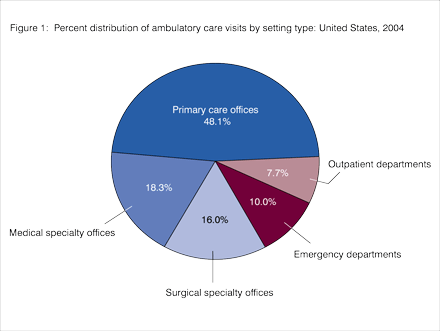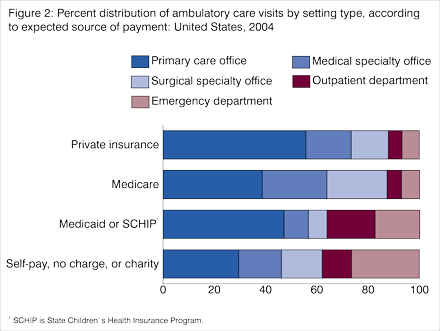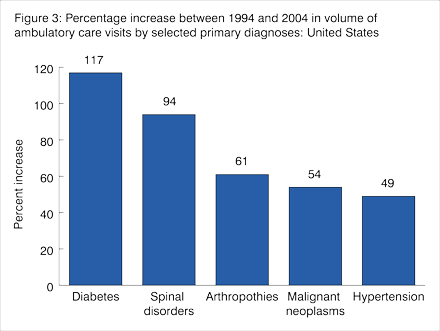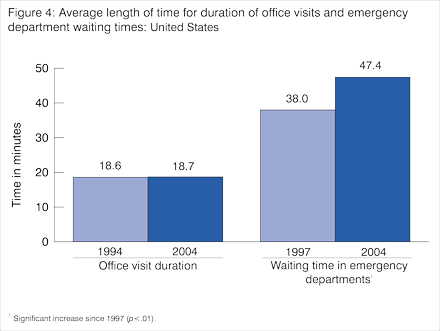Ambulatory Medical Care Utilization Estimates for 2004
by Catharine W. Burt, Ed.D.; Linda F. McCaig, M.P.H.; and Elizabeth A. Rechtsteiner, M.S., Division of Health Care Statistics
Americans made more than 1.1 billion visits a year to doctors’ offices and hospital emergency and outpatient departments in 2004, up by 31% in the last 10 years. A portion of this increase is due to an 11% rise in population during that period. This was accompanied by a 19% increase in utilization per person. The increase in the visit rate per person among persons 65 years and over (26%) was higher than among persons under age 65 years (16%).
Comparison of utilization by patient age between 1994 and 2004
| Number of visits in thousands | Number of visits per person1 | |||||
|---|---|---|---|---|---|---|
| Patient age | 1994 | 2004 | Percent change | 1994 | 2004 | Percent change |
| All ages | 841,204 | 1,106,067 | 31 | 3.2 | 3.8 | 19 |
| Under age 65 years | 654,183 | 843,333 | 29 | 2.9 | 3.3 | 16 |
| 65 years and over | 187,021 | 262,734 | 40 | 6.0 | 7.6 | 26 |
1 Based on the U.S. noninstitutional civilian population as of July 1, 2004.
Estimates of ambulatory medical care use are based on national probability provider-based surveys of visits to nonfederal office-based physicians and emergency and outpatient departments of nonfederal, general, and short-stay hospitals in the 50 states and the District of Columbia. Individual reports are available that contain detailed analysis by setting: “National Ambulatory Medical Care Survey: 2004 Summary” [PDF – 932 KB], “National Hospital Ambulatory Medical Care Survey: 2004 Emergency Department Summary” [PDF – 998 KB], and “National Hospital Ambulatory Medical Care Survey: 2004 Outpatient Department Summary” [PDF – 1.1 MB]. These reports, issued annually, provide a comprehensive analysis of visits to ambulatory health care settings in the United States. Estimates of visits are made from a sample of medical record abstracts from each sampled provider during defined reporting periods weighted to provide national annual estimates. More information on the sampling design and scope of the surveys can be found at the Ambulatory Health Care Data website.
This E-Stat presents summary information across physician offices and hospital emergency and outpatient departments. Physician offices are further classified by the physician specialty: primary care, surgical, and medical. The tables present total visits across all settings as well as percent distributions by setting type. Table 1 [PDF – 100 KB] presents the 2004 estimates of ambulatory care by setting and patient and geographic demographics. Table 2 [PDF – 100 KB] presents visit rates per 100 persons in the civilian noninstitutional U.S. population. Table 3 presents the leading primary diagnoses for ambulatory care visits, which account for over half of all visits.
One-half of the 1.1 billion visits (48.1 percent) were to primary care doctors in office-based practices. The rest were to medical specialists (18.3 percent) and surgical specialists (16.0 percent) in office-based practices and emergency departments (10.0 percent) and outpatient departments (7.7 percent) in nonfederal general and short-stay hospitals (Figure 1).
Data on primary expected source of payment show that no third-party payer (defined as self-pay, no charge, or charity) was expected to cover charges for 6.3 percent of ambulatory care visits (Table 1 [PDF – 100 KB] ). Hospital settings were used more frequently than physician offices for ambulatory care by Medicaid recipients and by patients with self-pay, no charge, or where charity was indicated as the expected source of payment (Figure 2).
Infants under 1 year of age had the highest rate of visits per population to primary care offices and hospital outpatient and emergency departments compared with other age groups studied (Table 2 [PDF – 100 KB] ).
Essential hypertension was the primary diagnosis recorded most frequently (42.1 million) at ambulatory care visits (Table 3 [PDF – 100 KB]). Significant increases over the last 10 years were found for most of the leading primary diagnoses at ambulatory care visits, including diabetes (up by 117%) and spinal disorders (up by 94%) (Figure 3).
There was no change in the average time a patient spent face-to-face with a physician in office settings (Figure 4). The amount of time a patient waited before seeing a physician in the emergency department increased from 38.0 minutes in 1997 (first year collected) to 47.4 minutes in 2004.
Future reports provide facility-level estimates of the structure and process of office-based physician practices and hospital emergency departments, as well as detailed estimates on medication therapy. These reports, covering 2003-04, will be available during the summer of 2006. Public-use micro-data visit files for 2004 are available from the Ambulatory Health Care Data website.




- Page last reviewed: November 6, 2015
- Page last updated: April 6, 2010
- Content source:


 ShareCompartir
ShareCompartir